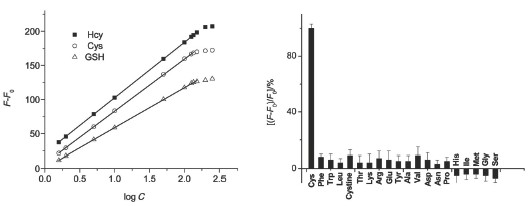| [1] Zhang, M.; Yin, B. C.; Tan, W. H.; Ye, B. C. Biosens. Bioelectron. 2011, 26, 3260.[2] Zhang, M.; Ye, B. C. Anal. Chem. 2011, 83, 1504.[3] Yoshitake, M.; Nohta, H.; Sejima, N.; Todoroki, K.; Yoshida, H.; Yamaguchi, M. Anal. Bioanal. Chem. 2011, 399, 1665.[4] Tay, L. L.; Tremblay, R. G.; Hulse, J.; Zurakowski, B.; Thompson, M.; Bani-Yaghoub, M. Analyst 2011, 136, 1620.[5] Sun, S. K.; Wang, H. F.; Yan, X. P. Chem. Commun. 2011, 47, 3817.[6] Niu, H.; Yuan, R.; Chai, Y.; Mao, L.; Yuan, Y.; Zhuo, Y.; Yuan, S.; Yang, X. Biosens. Bioelectron. 2011, 26, 3175.[7] Yang, T.; Chen, M. L.; Hu, X. W.; Wang, Z. W.; Wang, J. H.; Dasgupta, P. K. Analyst 2011, 136, 83.[8] Shao, J.; Guo, H.; Ji, S.; Zhao, J. Biosens. Bioelectron. 2011, 26, 3012.[9] Zuo, Q. P.; Li, B.; Pei, Q.; Li, Z. J.; Liu, S. K. J. Fluoresc. 2010, 20, 1307.[10] Huang, S.-T.; Ting, K.-N.; Wang, K.-L. Anal. Chim. Acta 2008, 620, 120.[11] Wang, J. G.; Lv, H.; Sun, Q. H.; Li, R. Z.; Zhong, Y.; Zhao, J.; Liu, M.; Jia, X. Acta Chim. Sinica 2009, 67, 415.(王建国, 吕慧, 孙巧花, 李荣志, 钟岩, 赵健, 刘敏, 贾香, 化学学报,2009, 67, 415.)[12] Xiong, L. Q.; Zhao, Q.; Chen, H. L.; Wu, Y. B.; Dong, Z. S.; Zhou, Z. G.; Li, F. Y. Inorg. Chem. 2010, 49, 6402.[13] Lim, S.; Escobedo, J. O.; Lowry, M.; Xu, X. Y.; Strongin, R. Chem. Commun. 2010, 46, 5707.[14] Park, K. S.; Kim, M. II; Woo, M.-A.; Park, H. G. Biosens. Bioelectron. 2013, 45, 65.[15] Zechmann, B.; Tomasic, A.; Horvat, L.; Fulgosi, H. Protoplasma 2010, 246, 65.[16] Wang, H.; Xian, M. Curr. Opin. Chem. Biol. 2011, 15, 32.[17] Han, B.; Wang, E. Biosens. Bioelectron. 2011, 26, 2585.[18] Dong, Y.; Li, J. Org. Lett. 2011, 13, 2252.[19] Yuan, L. Org. Lett. 2011, 14, 432.[20] Liu, T. T.; Peng, C.; Ma, Y. C.; Ouyang, J. Acta Chim. Sinica 2013, 71, 962. (刘亭廷, 彭程, 马云川, 欧阳津, 化学学报, 2013, 71, 962).[21] Xie, W. J.; Fu, Y. Y.; Ma, H.; Zhang, M.; Fan, L. Z. Acta Chim. Sinica 2012, 70, 2169. (谢文菁, 傅英懿, 马红, 张沫, 范楼珍, 化学学报, 2012, 70, 2169).[22] Yang, F.; Wang, L. L.; Guo, Z. H. Acta Chim. Sinica 2012, 70, 1283. (杨帆, 王伶俐, 郭志慧, 化学学报, 2012, 70, 1283).[23] Liu, Z. Q.; Liu, S. P.; Yan, S. G.; Yin, P. F.; He, R. Q. Acta Chim. Sinica 2011, 69, 2969. (刘正清, 刘绍璞, 闫曙光, 殷鹏飞, 何佑秋, 化学学报, 2011, 69, 2969).[24] Xu, J. P.; Jia, L.; Fang, Y. A.; Lv, L. P.; Song, Z. G.; Ji, J. A. Analyst 2010, 135, 2323.[25] Thomas, J.; Sherman, D. B.; Amiss, T. J.; Andaluz, S. A.; Pitner, J. B. Bioconjugate Chem. 2007, 18, 1841.[26] Yuan, J.; Guo, W.; Wang, E. Anal. Chem. 2008, 80, 1141.[27] Ali, E. M.; Zheng, Y.; Yu, H.-H.; Ying, J. Y. Anal. Chem. 2007, 79, 9452.[28] Suzuki, M.; Husimi, Y.; Komatsu, H.; Suzuki, K.; Douglas, K. T. J. Am. Chem. Soc. 2008, 130, 5720.[29] He, Y.; Wang, H.-F.; Yan, X.-P. Anal. Chem. 2008, 80, 3832.[30] Zou, L.; Gu, Z.; Zhang, N.; Zhang, Y.; Fang, Z.; Zhu, W.; Zhong, X. J. Mater. Chem. 2008, 18, 2807.[31] Zhang, Y.; Li, Y.; Yan, X.-P. Anal. Chem. 2009, 81, 5001. |
